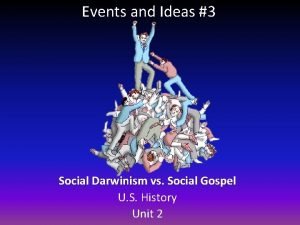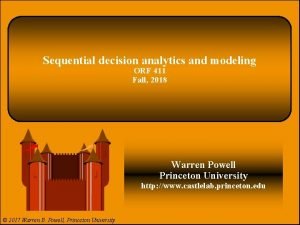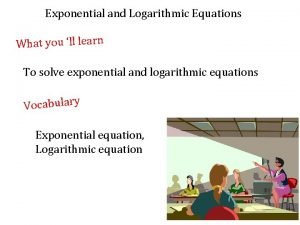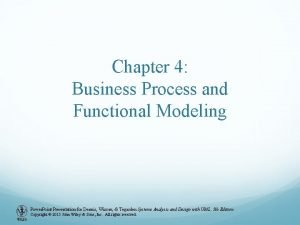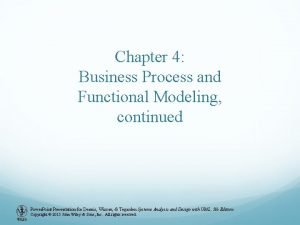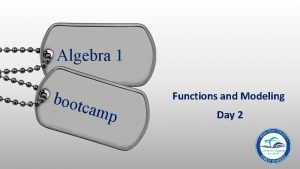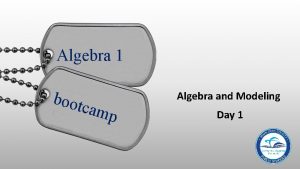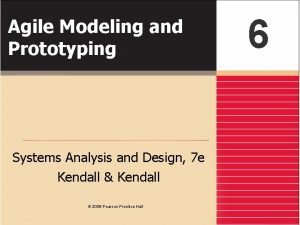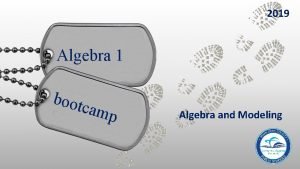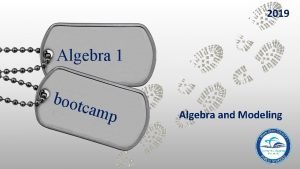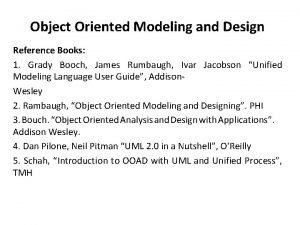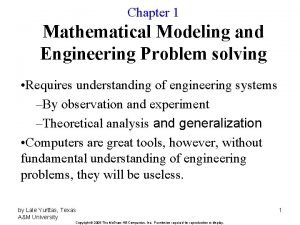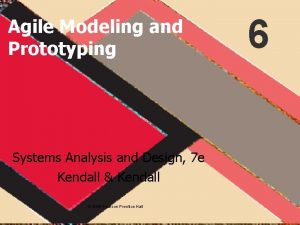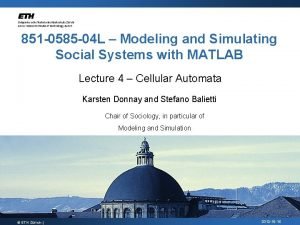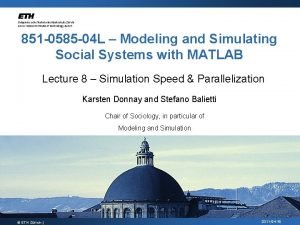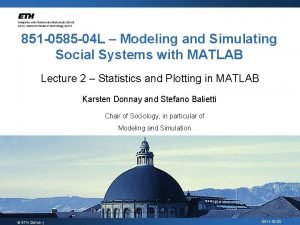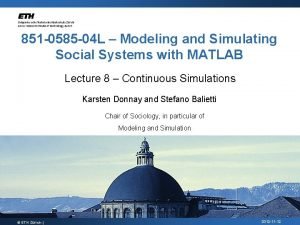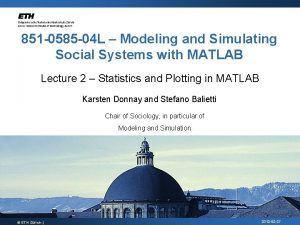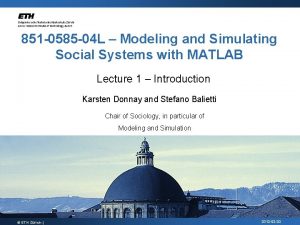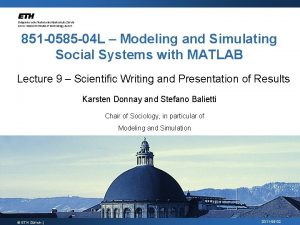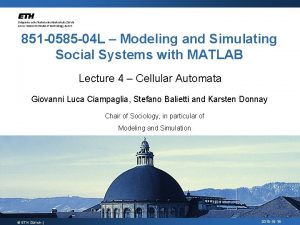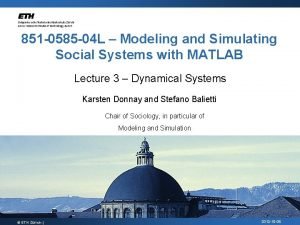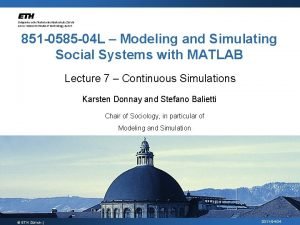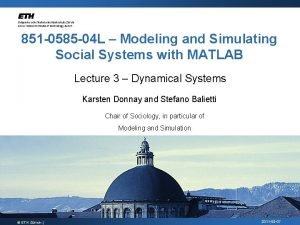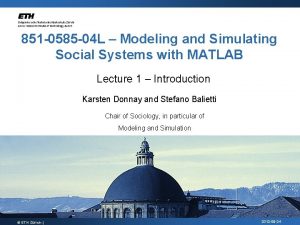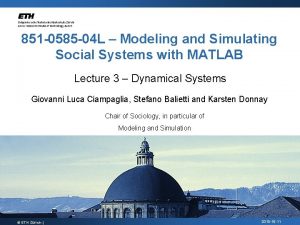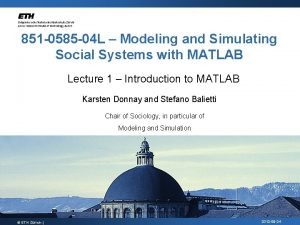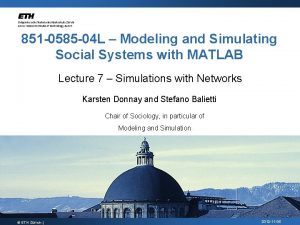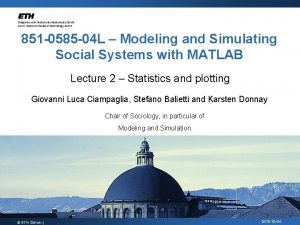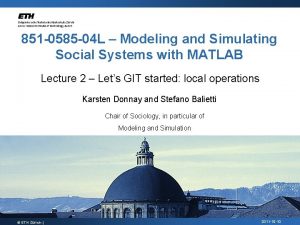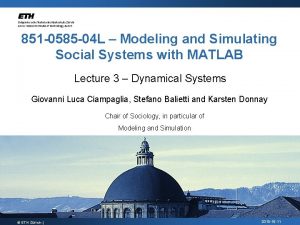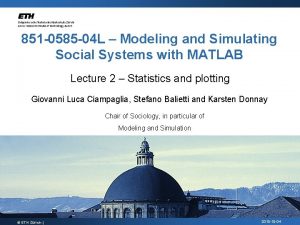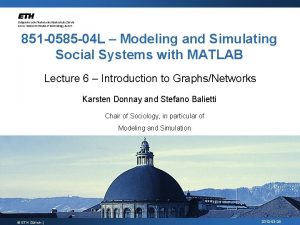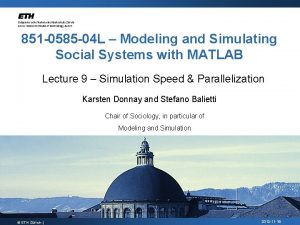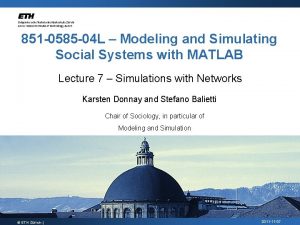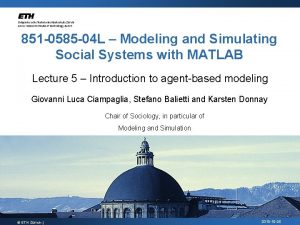851 0585 04 L Modeling and Simulating Social









































- Slides: 41

851 -0585 -04 L – Modeling and Simulating Social Systems with MATLAB Lecture 11 – Evolutionary Stability and Replicator Dynamics Karsten Donnay and Stefano Balietti Chair of Sociology, in particular of Modeling and Simulation © ETH Zürich | 2011 -12 -05

Schedule of the course Introduction to MATLAB 26. 09. 03. 10. 10. 17. 10. 24. 10. 31. 10. Working on projects (seminar thesis) No lecture, but we will be in the room to supervise you 07. 11. 14. 11. 21. 11. 28. 11. 05. 12. 12. 19. 12. 2011 -12 -05 Introduction to social-science modeling and simulations Handing in seminar thesis and giving a presentation K. Donnay & S. Balietti / kdonnay@ethz. ch sbalietti@ethz. ch 2

Final presentation schedule § Project presentation 15’ + 5’ (for Q&A) § 2 days available: Monday, Dec. 19 th 10. 20 - 13. 00 and 17. 30 – 19. 30 § Tuesday, Dec. 20 th 15. 00 - 18. 00 § § Registration for final presentation is binding; if you do not want to obtain credits, do not register! § Sign up for a presentation slot this week in class or via mailing list msssm@sympa. ethz. ch 2011 -12 -05 K. Donnay & S. Balietti / kdonnay@ethz. ch sbalietti@ethz. ch 3

Final presentation schedule § Presentations take place in the seminar room of the offices of the Chair of Sociology, in particular Modeling and Simulation § The seminar room is located on the first floor, first door on the right. Room C 1 § Enter without ringing the bell, but please keep silence in the corridor § http: //www. soms. ethz. ch/box_feeder/howtoreach. pdf 2011 -12 -05 K. Donnay & S. Balietti / kdonnay@ethz. ch sbalietti@ethz. ch 4

Final presentation schedule § Reminder: Your reports are due midnight of Friday December 16 th 2011 § Submission is through GIT: simply upload your report, source code, videos etc. before the deadline and we will retrieve it. In case of submission problems, please contact us beforehand. 2011 -12 -05 K. Donnay & S. Balietti / kdonnay@ethz. ch sbalietti@ethz. ch 5

Goals of Lecture 11: students will 1. Consolidate knowledge acquired during lecture 10, through brief repetition of the main points. 2. Review Schelling’s segregation model and its main results from a classical perspective 3. Understand the motivation and the rules behind a discrete time replicator dynamics equation 4. Receive a brief introduction to stability analysis in evolutionary models 5. Revisit Schelling’s segregation model from an evolutionary perspective 6. Reflect about the main message of the course 2011 -12 -05 K. Donnay & S. Balietti / kdonnay@ethz. ch sbalietti@ethz. ch 6

Repetition: statistical testing § Statistical tests tell us how sure we can be that our simulation reproduces an empirical observation § Testing represent the closure of the modeling cycle § Statistical test of your simulation results is NOT a requisite for passing this course 2011 -12 -05 K. Donnay & S. Balietti / kdonnay@ethz. ch sbalietti@ethz. ch 7

Repetition: scientific writing § § § All claims must be well justified Correlation is not causation Most of the time scientific writing is “standardized” 2011 -12 -05 K. Donnay & S. Balietti / kdonnay@ethz. ch sbalietti@ethz. ch 8

Modeling Population Dynamics In many American cities racial segregation can be traced back to separated neighborhood for people of different race. However, when interviewed most of the people said they prefer to live in integrated neighborhoods. Clark(1991) 2011 -12 -05 K. Donnay & S. Balietti / kdonnay@ethz. ch sbalietti@ethz. ch 9

Modeling Population Dynamics § In large populations, how do persistent structures of interaction evolve in the absence of deliberate design? § Understanding individual’s preferences and beliefs may allow us the prediction of individual behavior § To explain aggregate outcomes we cannot simply sum up the predicted individual behaviors § The actions taken by each individual typically affect the constraints, beliefs, or preferences of others. 2011 -12 -05 K. Donnay & S. Balietti / kdonnay@ethz. ch sbalietti@ethz. ch 10

Schelling’s Segregation Model § § Cellular automata § Result: local myopic interaction determines global segregation pattern. Individuals prefer integration Individuals do not want be part of the minority Individuals can relocate themselves if they are not happy with their current situation 2011 -12 -05 K. Donnay & S. Balietti / kdonnay@ethz. ch sbalietti@ethz. ch 11

Schelling’s Segregation Model: demo 2011 -12 -05 K. Donnay & S. Balietti / kdonnay@ethz. ch sbalietti@ethz. ch 12

Evolutionary models § Evolutionary models of population mimic the dynamics of biological system under the combined influence of: 1. 2. 3. 4. Chance Inheritance Natural Selection Path-dependence (historical contingency) 2011 -12 -05 K. Donnay & S. Balietti / kdonnay@ethz. ch sbalietti@ethz. ch 13

Evolutionary models § Individuals are bearer of behavioral rules (traits) which can spread to the whole population or remain confined in a niche. § The transmission can take place through different mechanisms: § Differential replication: genetic or cultural § From parents: vertical transmission: § From others: oblique transmission § From members of the group: horizontal 2011 -12 -05 K. Donnay & S. Balietti / kdonnay@ethz. ch sbalietti@ethz. ch 14

Evolutionary models 1. Individual implements a strategy dictated by its genetic or behavioral trait Loop for 1: N 2. Individual play the strategy against 1. The Environment 2. Other randomly paired individuals 3. A certain payoff is granted Learning Natural Selection 2011 -12 -05 4. An individual can update his strategy 5. Replication relative to payoff K. Donnay & S. Balietti / kdonnay@ethz. ch sbalietti@ethz. ch 15

Replicator Equation § § Gives complete account of out-of-equilibrium dynamics Discover evolutionary irrelevant equilibria Some non-equilibrium states are of substantial importance Population is hierarchically structured and differential replication ca take place at more than one level 2011 -12 -05 K. Donnay & S. Balietti / kdonnay@ethz. ch sbalietti@ethz. ch 16

Discrete Time Replicator Equation § § § 2011 -12 -05 Assume a population is divided in two groups: x and y At each time step individuals are randomly paired. They expected payoff E(B) for the group would depend on: § The relative frequency p of the group in the population § The relative payoff π for the strategy of each group K. Donnay & S. Balietti / kdonnay@ethz. ch sbalietti@ethz. ch 17

Discrete Time Replicator Equation § The expected population frequency for trait x at time t+1 can be written as the sum: § where ω is the fraction of population in “update state”, and β is a positive constant that renormalize small differences in payoff 2011 -12 -05 K. Donnay & S. Balietti / kdonnay@ethz. ch sbalietti@ethz. ch 18

Discrete Time Replicator Equation § And the population differential would be: § Δp will be the greater: § The greater the fraction of population in “update-state”: ω § The greater the sensitivity of the population to small differences in payoff: β § The greater the possibility to meet other population groups: p -> 1/2 § The greater the difference in payoff: bx – by 2011 -12 -05 K. Donnay & S. Balietti / kdonnay@ethz. ch sbalietti@ethz. ch 19

Discrete Time Replicator Equation § The replicator equation can be generalized to n traits: § where b_hat is the average population payoff. § P. D. Taylor and L. B. Jonker, Evolutionary stable strategies and game dynamics. Mathematical Biosciences, 40 (1978), pp. 145– 156. § This update rule is also called payoff monotonic update. 2011 -12 -05 K. Donnay & S. Balietti / kdonnay@ethz. ch sbalietti@ethz. ch 20

Stability Analysis § For each value of p the replicator equation gives us the velocity and direction of change of the state. § We are interested in studying those values of p such that Δp = 0 § which identify a stationary state or a fixed point. 2011 -12 -05 K. Donnay & S. Balietti / kdonnay@ethz. ch sbalietti@ethz. ch 21

Stability Analysis § Apart from trivial cases (which? ), Δp takes the sign of bx – b_hat, which reflects the monotonic update rule. § Intuitively, in order to be stable a state needs a corrective feedback mechanism which counteract a change in Δp § In this case, a state is stable if its derivative on respect to p is negative. 2011 -12 -05 K. Donnay & S. Balietti / kdonnay@ethz. ch sbalietti@ethz. ch 22

Stability Analysis § An equilibrium p* is said to be Lyapunov stable if for any small enough perturbation, the system will not move further away. 2011 -12 -05 K. Donnay & S. Balietti / kdonnay@ethz. ch sbalietti@ethz. ch 23

Stability Analysis § An equilibrium p* is said to be asymptotically stable if for any small enough perturbation the system can return to p* § An asymptotically stable state is also Lyapunov stable 2011 -12 -05 K. Donnay & S. Balietti / kdonnay@ethz. ch sbalietti@ethz. ch 24

Visual Classification of Fixed Points Stable node Unstable focus 2011 -12 -05 Unstable node Stable focus Elliptic point (stable limit cycle) Saddle point K. Donnay & S. Balietti / kdonnay@ethz. ch sbalietti@ethz. ch 25

Neighborhood Segregation as an Evolutionary Process Samuel Bowles. Microeconomics. Behavior, Institutions, and Evolutions. Princeton University Press. 2006 2011 -12 -05 K. Donnay & S. Balietti / kdonnay@ethz. ch sbalietti@ethz. ch 26

Assumptions § A neighborhood is composed by two ethnic groups (X, Y) § Both have a preference for integrated neighborhoods, but none of them want to be part of the minority. § Their preference is reflected in the price that they would pay for a house. § Where δ is the differential preference for one’s own trait, K is the unbiased price of the house 2011 -12 -05 K. Donnay & S. Balietti / kdonnay@ethz. ch sbalietti@ethz. ch 27

Assumptions § At each time step a fraction α of the population is selling a house § Prospective buyers from outside the neighborhood visit it proportionally to the current composition § Buyers and sellers are randomly matched § Each seller meets just one buyer period § A sale is concluded if the buyer’s evaluation of the house is higher than the one of the seller. 2011 -12 -05 K. Donnay & S. Balietti / kdonnay@ethz. ch sbalietti@ethz. ch 28

The Replicator Dynamic Equation § We can write the replicator equation as follows: Probability that X is in update-state, meet Y and have higher (lower) differential payoff 2011 -12 -05 K. Donnay & S. Balietti / kdonnay@ethz. ch sbalietti@ethz. ch 29

Stability Analysis § We are now looking if a change in Δp is self-correcting. § Unfortunately, in our case the inequality does not hold § That means that although p = 0. 5 is a fixed point, is not a stable one. Small perturbations will drive the system into a new state 2011 -12 -05 K. Donnay & S. Balietti / kdonnay@ethz. ch sbalietti@ethz. ch 30

Stability Analysis: delta = 0. 1 2011 -12 -05 K. Donnay & S. Balietti / kdonnay@ethz. ch sbalietti@ethz. ch 31

Stability Analysis: delta = 0 2011 -12 -05 K. Donnay & S. Balietti / kdonnay@ethz. ch sbalietti@ethz. ch 32

Stability Analysis: delta = 0. 5 2011 -12 -05 K. Donnay & S. Balietti / kdonnay@ethz. ch sbalietti@ethz. ch 33

Thank you very much! 2011 -12 -05 K. Donnay & S. Balietti / kdonnay@ethz. ch sbalietti@ethz. ch 34

The Take Home Message of the Course § Finding good questions is as important as finding good answers. “The formulation of a problem is often more essential than its solution which may be merely a matter of mathematical or experimental skills. ” 2011 -12 -05 K. Donnay & S. Balietti / kdonnay@ethz. ch sbalietti@ethz. ch Albert Einstein (14 Mar 1879 – 18 Apr 1955) 35

The Take Home Message of the Course § Simulation is a relatively new and heterogeneous research method: § networks, grids, continuous space, dynamical systems, rational agents, evolutionary models etc. § Simulation focuses on micro-mechanisms Vs U. S. A. 50 states 2011 -12 -05 K. Donnay & S. Balietti / kdonnay@ethz. ch sbalietti@ethz. ch 36

The Take Home Message of the Course § Emergence: § 2011 -12 -05 “Interactions among objects at one level give rise to different types of objects at another level. ” K. Donnay & S. Balietti / kdonnay@ethz. ch sbalietti@ethz. ch 37

Goals of the course: students have… ? 1. Acquired firm understanding of the basics of MATLAB. 2. Attained practical knowledge of MATLAB necessary to run computer simulations. 3. Learned how to implement (simple) models of various social processes and systems, replicating and extending established models of the literature. 4. Developed independence in adequately individuating and selecting further literature (internet, books, paper…) to expand your knowledge of MATLAB 5. Became confident in presenting scientific results in academic context (still in progress…). 2011 -12 -05 K. Donnay & S. Balietti / kdonnay@ethz. ch sbalietti@ethz. ch 38

(Quality? ) Survey § § Completely anonymous Takes 5 minutes We really read the results Results are used for planning next semester course § http: //www. surveymonkey. com/s/DXJL 567 2011 -12 -05 K. Donnay & S. Balietti / kdonnay@ethz. ch sbalietti@ethz. ch 39

References § WAV Clark. Residential preferences and neighborhood racial segregation: a test of the Schelling segregation model. Demography (1991) § Samuel Bowles. Microeconomics. Behavior, Institutions, and Evolutions. Princeton University Press. 2006 § http: //www. radicalcartography. net 2011 -12 -05 K. Donnay & S. Balietti / kdonnay@ethz. ch sbalietti@ethz. ch 40

References § P. D. Taylor and L. B. Jonker, Evolutionary stable strategies and game dynamics. Mathematical Biosciences, 40 (1978), pp. 145– 156. § V. Nemytsky and V. Stepanov, Qualitative Theory of Differential Equations (Princeton University, Princeton, 1960) 2011 -12 -05 K. Donnay & S. Balietti / kdonnay@ethz. ch sbalietti@ethz. ch 41
 Heat stiffening and cold stiffening
Heat stiffening and cold stiffening Postmortem signs
Postmortem signs Modeling and role modeling theory
Modeling and role modeling theory 10 cfr 851
10 cfr 851 Health and safety act ontario
Health and safety act ontario 20 x 3
20 x 3 Dimensional modeling vs relational modeling
Dimensional modeling vs relational modeling National general foundation health
National general foundation health Ngic 888-781-0585
Ngic 888-781-0585 Apa itu social thinking
Apa itu social thinking Social thinking social influence social relations
Social thinking social influence social relations Data and process modeling
Data and process modeling Linear and quadratic functions and modeling
Linear and quadratic functions and modeling Dfd chapter 5
Dfd chapter 5 Social darwinism vs social gospel
Social darwinism vs social gospel Simulation modeling and analysis law kelton
Simulation modeling and analysis law kelton Sequential decision analytics and modeling
Sequential decision analytics and modeling Modeling with exponential and logarithmic equations quiz
Modeling with exponential and logarithmic equations quiz Answers key
Answers key System requirements checklist output example
System requirements checklist output example Business process and functional modeling
Business process and functional modeling Business process and functional modeling
Business process and functional modeling Unplanned model aba
Unplanned model aba Perbedaan imitasi dan modeling
Perbedaan imitasi dan modeling Algebra 1 bootcamp functions and modeling
Algebra 1 bootcamp functions and modeling 2019 algebra 1 bootcamp answers
2019 algebra 1 bootcamp answers Algebra 1 bootcamp functions and modeling
Algebra 1 bootcamp functions and modeling Patched up prototype
Patched up prototype Additive and subtractive modeling
Additive and subtractive modeling Patched-up prototype
Patched-up prototype 2019 algebra 1 bootcamp answers
2019 algebra 1 bootcamp answers Joanna has a total of 50 coins in her purse
Joanna has a total of 50 coins in her purse Object oriented modeling and design books
Object oriented modeling and design books Pharmaceutical simulation and modeling
Pharmaceutical simulation and modeling Introduction to modeling and simulation
Introduction to modeling and simulation Data vault modeling pros and cons
Data vault modeling pros and cons Mathematical modeling and engineering problem solving
Mathematical modeling and engineering problem solving Biomedical modeling and simulation
Biomedical modeling and simulation Device modeling for analog and rf cmos circuit design
Device modeling for analog and rf cmos circuit design Agile modeling and prototyping
Agile modeling and prototyping Additive and subtractive modeling
Additive and subtractive modeling Simulasi itu apa
Simulasi itu apa














